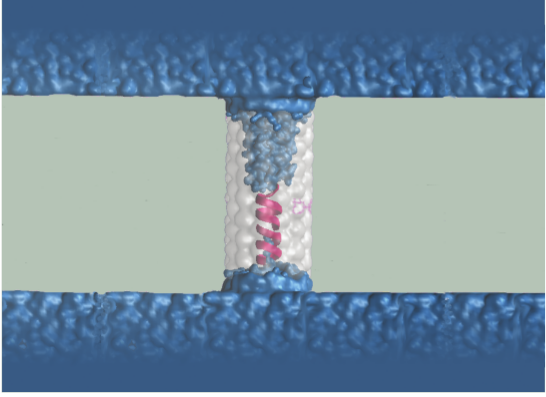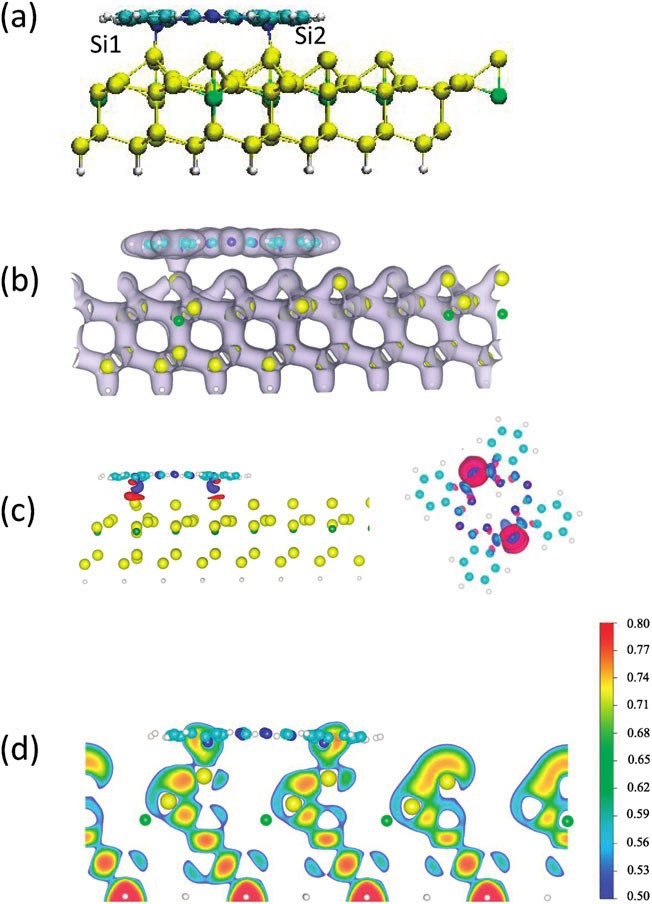Résultats scientifiques
Présentation de quelques résultats obtenus au mésocentre
Biomimetic solution against dewetting in a highly hydrophobic nanopore
A protein confined inside a highly hydrophobic dried nanopore restores wetting by water progressive pumping.
Highlighting work from Picaud et al., NIT (Besancon),
CIMAP (Caen), IEM and LCC (Montpellier) supported by
French Research Program ANR-BLANC, Project TRANSION
(ANR-2012-BS08-0023)
A water molecule is the foundation of life and symbolizes the primary compound in every living system. While many of its properties are understood in bulk solvent, its behavior in a small hydrophobic nanopore still raises fundamental questions. For instance, a wetting/dewetting transition in a hydrophobic solid-state or polymer nanopore occurs stochastically and can only be prevented by external physical stimuli. Controlling these transitions would be a primary requirement to improve many applications. Some biological channels, such as gramicidin A (gA) proteins, show a high rate of water and ion diffusion in their central subnanochannel while their external surface is highly hydrophobic. The diameter of this channel is significantly smaller than the inner size of the lowest artificial nanopore in which water drying occurs (i.e. 1.4nm). In this paper, we propose an innovative idea to generate nanopore wetting as a result of which the application of an external field is no longer required. In a nanopore, the drying or wetting of the inner walls occurs randomly (in experiments and in simulations). However, we have shown how the confinement of gA, in a dried hydrophobic nanopore, rapidly generates a stable wetting of the latter. We believe that this simple idea, based on biomimetism, could represent a real breakthrough that could help to improve and develop new nanoscale applications.

Replicability and impact of statistics in the detection of neural responses of consciousness
Damien Gabriel, 1,2 Emelyne Muzard, 3 Julie Henriques, 4,5 Coralie Mignot, 1 Lionel Pazart, 1,2
Nathalie André-Obadia, 6,7 Juan-Pablo Ortega, 8,9 and Thierry Moulin 1,2,3
Brain Advance Access published March 26, 2016 (doi:10.1093/brain/aww065)
1) Centre d’Investigation Clinique CIC 1431, Inserm, CHRU Besançon, F-25000 Besançon, France
2) Neurosciences intégratives et cliniques EA 481, Univ. Franche-Comté, Univ. Bourgogne Franche-Comté, F-25000 Besançon,
France
3) Service de Neurologie, CHRU Besançon, F-25000 Besançon, France
4) Laboratoire de Mathématiques de Besançon, F-25000 Besançon, France
5) Cegos Deployment, F-25000 Besançon, France
6) Service de Neurophysiologie et d’Épileptologie, Hôpital Neurologique P.-Wertheimer, Hospices Civils de Lyon, 69677 Bron cedex,
France
7) Inserm U 1028, Équipe NeuroPain, Centre de Recherche en Neuroscience de Lyon (CRNL), Université Lyon 1, 69677 Bron cedex,
France
8) Centre National de la Recherche Scientifique, F-25000 Besançon, France
9) Faculty of Mathematics and Statistics, Universität St. Gallen, Switzerland
A new assisted molecular cycloaddition on boron doped siliconsurfaces: a predictive DFT-D study
K. Boukari, E. Duverger, L. Stauffer, P. Sonnet
Physical Chemistry Chemical Physics: Phys. Chem. Chem. Phys., 16,12164-12171 (2014)
DOI: 10.1039/C4CP00839A

Etude de l'adsorption sur la surface de la molécule H2PC sur une surface SiB avec un Défaut: (a) la structure atomique de la configuration optimisée. Les atomes N1 et N2 sont situés juste au-dessus des adatomesSi1 et Si2; (b) des densités de charge ; (c) variation de charge électronique en bleu une augmentation en rouge une diminution; (d) calcul la représentation ELF (fonction de localisation électronique per mettant d’étudier les liaisons.
Calculs réalisés et publiés avec VASP 5.3.0 ; 40000 h calculs.
Experimental and simulation studies of unusual current blockade induced by translocation of small oxidized PEG through a single nanopore
S. Cabello-Aguilara, A. Abou Chaayaa, F. Picaudb, M. Bechelanya, C. Pochat-Bohatiera, S. Yesylevskyyc, S. Kraszewskib, M. C. Bechelanyd, F. Rossignold, E. Balanzate, JM. Janota, P.Mielea, P. Dejardina and S. Balmea
Phys. Chem. Chem. Phys., 2014,16, 17883-17892
DOI: 10.1039/C4CP01954G

Simulations par dynamique moléculaire de la diffusion de molécules de Polyéthylène Glycol (PEG) au sein d’un nanopore hydrophobe de différents diamètres (ou propriétés physiques).
Calculs effectués par NAMD et publiés conjointement à l’expérience ;
CPUTime: ~42000H (par PEG et par pore simulé) .
This work was financed by the ANR (Agence Nationale de la Recherche,
France) via the project “TRANSION” (ANR-2012-BS08-0023) [Coordinator and
Partners: Prof. Henn François, Dr Jourdain Vincent, Dr Balme Sébastien
(Univ. Montpellier), Dr Manghi Manoel (Univ. Toulouse), and Dr Picaud
Fabien (Univ. Besançon)]





